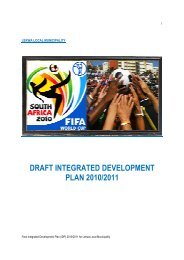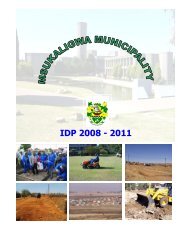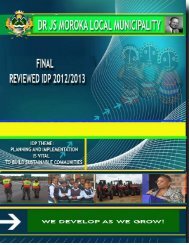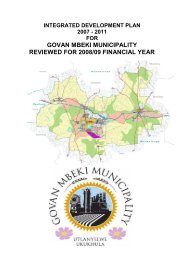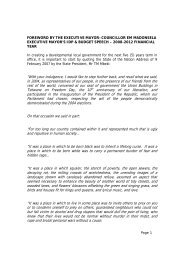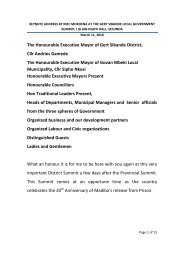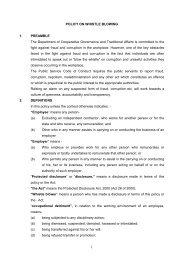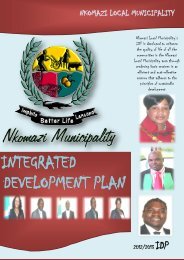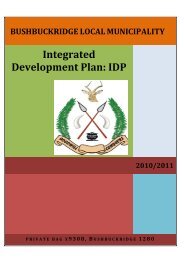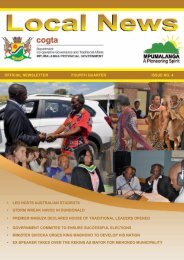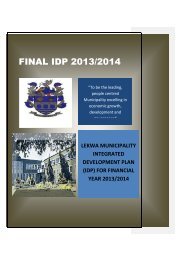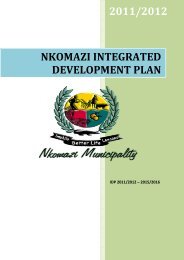Govan Mbeki Local Municipality 2011/12 - Co-operative ...
Govan Mbeki Local Municipality 2011/12 - Co-operative ...
Govan Mbeki Local Municipality 2011/12 - Co-operative ...
You also want an ePaper? Increase the reach of your titles
YUMPU automatically turns print PDFs into web optimized ePapers that Google loves.
maximum precipitation is either January or February. The western portions of the<br />
municipality can receive between 600-800mm/year and the eastern portion can receive<br />
between 800-1000mm/year.<br />
In summer, temperatures range from as high as 40 degree Celsius during the day to<br />
10 degree Celsius in the evenings. Winters are milder and temperatures usually vary<br />
between 20 degrees Celsius during the day and 10 degree Celsius in the evenings.<br />
Frost does occur, but apart from light frost which may occur from May to August, the<br />
period during which ordinary frosts may be expected is less than 30 days per year.<br />
Five pollution transport pathways across the Highveld with regards to wind direction<br />
were determined according to wind directions over South Africa. The most relevant<br />
transport pathways in the Gert Sibande District <strong>Municipality</strong> are the direct transport<br />
towards the Indian Ocean and recirculation over the subcontinent.<br />
1.2.7 Topography / Geology / Soil Potential:<br />
<strong>Govan</strong> <strong>Mbeki</strong> is fairly flat with no areas with a slope of more than 9%. The municipality<br />
falls within the Karoo Super group. The underlying rock types of the area are<br />
dominated by the presence of dolerite intrusion, arenite and rhyolite deposits.<br />
The soil potential varies from a poor suitability for agriculture on the northern border<br />
and south western regions. The soil potential in the area is impacted upon by mining<br />
activities as well as by unsuitable agricultural activities and the use of pesticides which<br />
inflict negative impact on the quality and arability of the soil.<br />
1.2.8 Hydrology and Wetlands:<br />
<strong>Govan</strong> <strong>Mbeki</strong> <strong>Municipality</strong> straddles the divide between the Upper Vaal Water<br />
Management Area, and the Olifants River WMA in the Noorth of the municipality. Due<br />
to the location of a major continental divide (watershed) which runs east to west across<br />
the municipality, the rivers in the municipality flow either in a northerly or southerly<br />
direction.<br />
The Trichartspruit flows northwards from the municipality, and forms the part of the<br />
upper catchment of the Olifants River. The Blesbokspruit, which flows through Bethal,<br />
and the Waterval River, drains southwards towards the Vaal River in the South. The<br />
headwaters of the Suikerbosrant River rise in the municipality and flow out of the<br />
municipality in the west. Both the upper Olifants and Waterval (Vaal) catchments are<br />
seriously impacted by concentration of mining and industry in the Secunda area. River<br />
ecosystems in this area are generally in a fair to poor condition.<br />
Both pans and palustrine (marsh/vlei) wetlands occur in the municipality. A large (vlei)<br />
wetland system occurs along the Suikerbosrant River and a number of small nonperennial<br />
pans exist. Extensive seepage areas exist in the streams and rivers draining<br />
northwards from\the municipality.<br />
These areas play an important role in the hydrological functioning of the Olifants River,<br />
attenuating water and through the slow release of water ensuring perennial flow within<br />
the upper catchment. The drainage of wetlands as well as the industrial and<br />
agricultural activities that are taking place in the municipality have a negative impact<br />
upon the water quality and hydrological systems of the municipality.<br />
<strong>12</strong>



